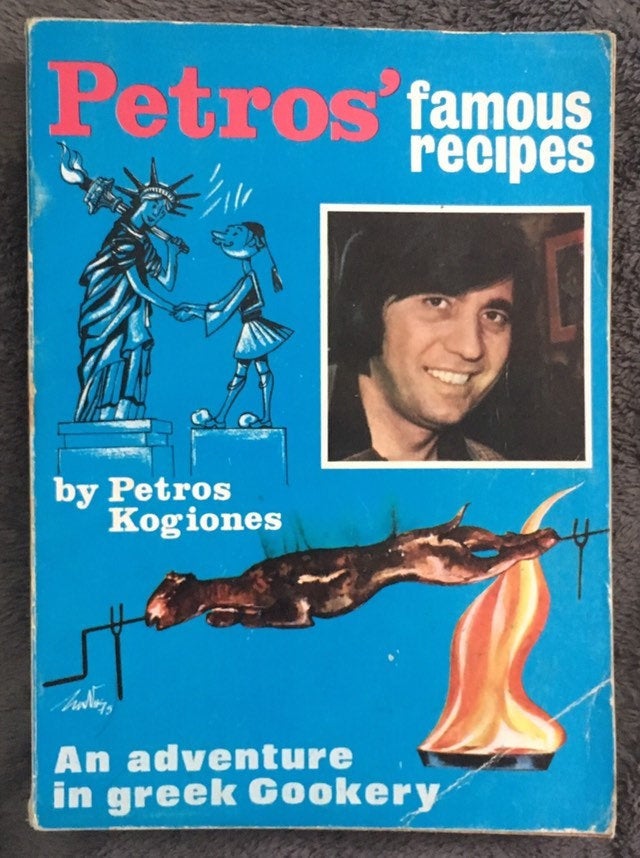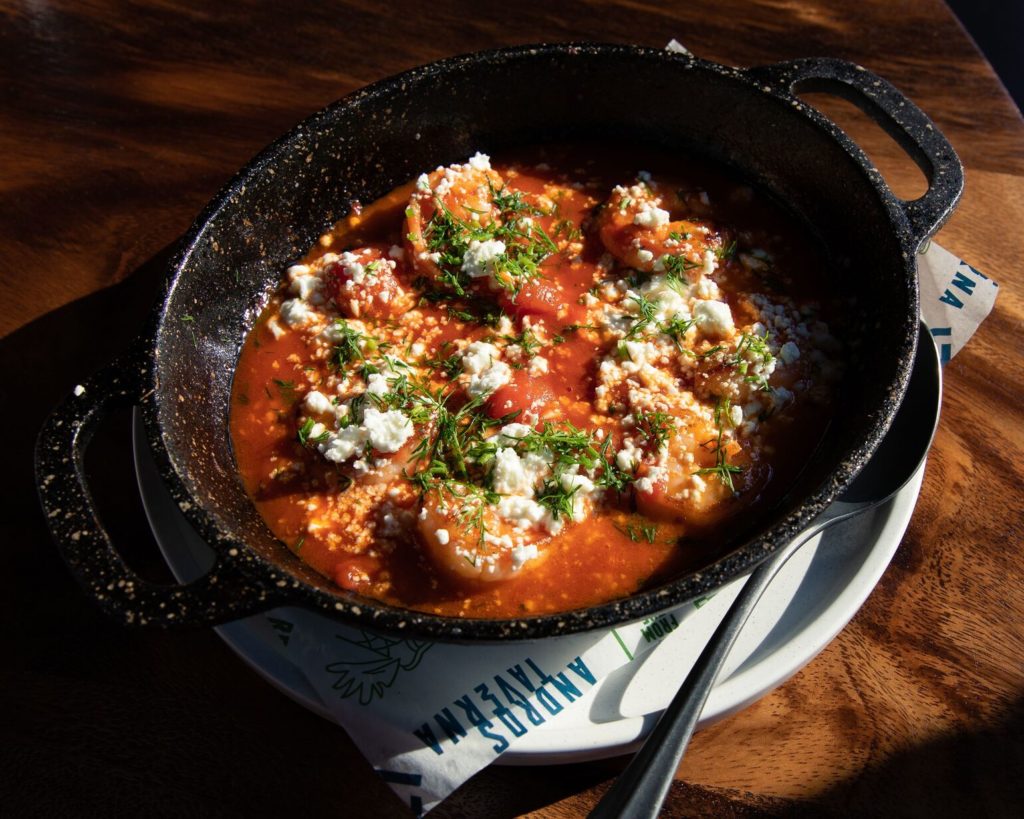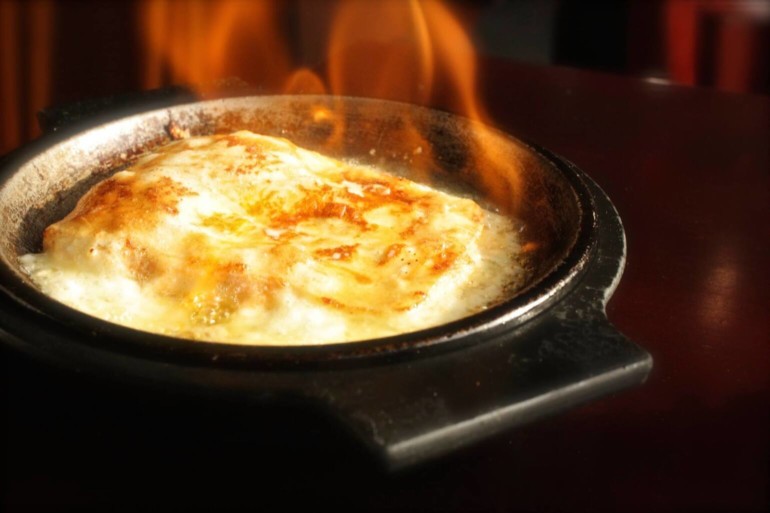Saganaki, the shallow pan of cheese set on fire tableside and squirted with lemon before serving, is the must-have starter at many of Chicago’s Greek restaurants. Flaming saganaki, however, is rarely found in Greece, at least outside of touristy areas.
Now enjoyed in stateside Greek restaurants from New York to Los Angeles, flaming saganaki seems to have been invented in Chicago. But where? Not an easy question to answer.
Petros Kogeones was the colorful host/owner at the now-closed — and legendary — Dianna’s Opaa! (212 S. Halsted, closed) in Greektown; in the 1970s, in the evenings, he’d frequently take his position in the front of the restaurant, serving ouzo to those waiting in line to get in, charming the ladies while vigorously schmoozing the guys. Kogeones was a character and the most vocal popularizer of the idea that he himself was the inventor of the flaming Greek cheese. According to a 1991 article in the Chicago Tribune, “The history of Dianna’s goes back to the early 1960s when Petros and his brother Peter put tables in the front of Peter’s grocery, in old Greektown, at Halsted and Harrison. Petros was a student at the time, and he brought friends from Navy Pier College, and the rest of the outside world followed. The Kogeones brothers doused cheese pie appetizers with brandy, lit them up and cried ‘Opaa!’ the ‘Greek exclamation of approval,’ says Petros.”

Kogeones presents one version of how flaming saganaki came to be. However, like so many Chicago original foods — Italian beef, deep dish pizza and others — such origin stories frequently lack solid documentation and are fiercely contested.
The Parthenon (314 S. Halsted, closed) was also believed, by some, to be the birthplace of flaming saganaki. Indeed, it seems most writers on the topic side with The Parthenon’s version of saganaki’s origin story. In 2018’s “Lost Restaurants of Chicago,” historian Greg Borzo records that “The bygone Parthenon… is widely credited with inventing in 1968 the flaming saganaki and ‘Opaa’ custom.”
Parthenon owner Chris Liakouras was quoted in the Chicago Tribune as saying, “I invented saganaki at this table in 1968. I was sitting here with three lady friends. We were talking about different things we could do. When a cheese dish was mentioned, one of the ladies said, ‘Why don’t you try flaming it?’”
The origins of Chicago’s blazing pan of cheese remain cloudy, but one thing’s for sure: flaming saganaki did not originate in the Greek islands. Flame-free saganaki, however, has been popular in Homer’s home base for a long time.
The word “saganaki” comes from the Greek word for a small pan with two handles: sagani. Foods cooked in this small pan become saganaki (-aki is a diminutive suffix in Greek, somewhat like the “y” suffix in English). In Chicago, saganaki usually means flaming cheese, though more and more Chicagoland restaurants are serving the un-flamed version.
Flaming saganaki is a beautiful example of a traditional food from another country that has been modified by Chicagoans to pique the interest of local diners. The same *fusion* of foreign and domestic culinary traditions is evident in the deep dish pizza and Chicago corn roll tamale.
The flaming of the cheese and accompanying shouts of “Opaa!” seem mostly designed to market the menu item, though the brandy does confer another dimension of flavor to the cheese, and it’s a fun and celebratory dish to have before dinner. Of course, if you’re going to serve flaming cheese in Chicago, the unwritten rule is that you must ritualistically exclaim “Opaa!” while doing so… though you know what they say about rules being made to be broken.
Newer Greek restaurants are turning down the intensity of the presentation. At Grapes & Grains (858 W. Lake), co-owner Dimitri Anastos – whose saganaki is flamed with cognac rather than ouzo or Metaxa – tells us, “We didn’t want a big flame, but rather a nice little classy flame to light the room for just a moment. It’s been traditional in Greektown (neighboring us) to light the saganaki and say ‘Opaa.’ We’re simply lighting it, but we’re not disturbing the live piano singer by yelling out ‘Opaa.’ The flame is a little theater that helps heat up the night.”

In Greece, you would find lots of different types of cheese — including kasseri, feta, and halloumi — warmed up in a pan, much as the French might warm dishes of raclette. Relatively dry cheeses are preferred because they don’t melt all over the place. Drier cheeses maintain their shape, more or less, despite the hot pan and the flaming finale.
If you’re serving saganaki at home, you might try to do it as the Greeks do, by simply warming the cheese in a pan and serving it sans flames. This more traditional approach of serving cheese warmed but not flaming in a sagani is undergoing a revival at some of Chicago’s chef-driven Greek and Mediterranean restaurants. Chef Doug Psaltis of Andros Taverna remembers, “we used to have traditional Greek food at home, and that includes saganaki, but my father would never set it on fire: it’d burn off his mustache! When I would go to Greece as a kid, we had saganaki with prawns and without flames, and that’s how we serve it at Andros Taverna.”

At Avli in Lincoln Park (1335 W. Wrightwood), they serve a delicious un-flamed version dressed with peppered figs and honey… but at their Winnetka location (566 Chestnut), they still serve it flamed. Old habits die hard — and we get that: people might be somewhat put out if they can’t start a Greek feast with a flaming cheese. According to owner/chef Louis Alexakis, “Winnetka opened 12 years ago; at that time, Chicago recognized flaming cheese as authentic Greek. Now we know that it was invented in Chicago. I traveled to many different areas to taste contemporary Greek dishes, and I tasted a saganaki in Sydney, Australia, with peppered figs. I decided to recreate a similar version in Lincoln Park. In our newest concept, Avli on The Park in Lakeshore East, the chef is topping saganaki with tomato marmalade.”

If you’re looking for the old school (meaning mid-century) way of preparing flaming saganaki, you might check out the following restaurants, still located on a slowly changing strip of Halsted in what was once the much larger and livelier Greektown of Chicago.
Greek Islands
200 S. Halsted, Chicago
312.782.9855
Athena Restaurant
212 S. Halsted, Chicago
312.655.0000
Artopolis
306 S. Halsted, Chicago
312.559.9000
More from Better:
- Evanston’s Lucky Platter Turns 30
- At Last, We Can Go To Dinner: Three Chicago Restaurant Openings
- Great North Shore Restaurants: Where to Eat in Winnetka and Northfield

David Hammond is Dining and Drinking Editor at Newcity and contributes to the Chicago Tribune and other publications. In 2004, he co-founded LTHForum.com, the 15,000 member food chat site; for several years he wrote weekly “Food Detective” columns in the Chicago Sun-Times; he writes weekly food columns for Wednesday Journal. He has written extensively about the culinary traditions of Mexico and Southeast Asia and contributed several chapters to “Street Food Around the World.”
David is a supporter of S.A.C.R.E.D., Saving Agave for Culture, Recreation, Education and Development, an organization founded by Chicagoan Lou Bank and dedicated to increasing awareness of agave distillates and ensuring that the benefits of that awareness flow to the villages of Oaxaca, Mexico. Currently, S.A.C.R.E.D is funding the development of agave farms, a library and water preservation systems for the community of Santa Catarina Minas, Oaxaca.

